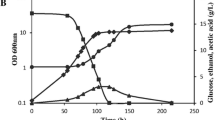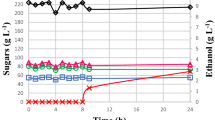Abstract
The influence of pH, temperature and carbon source (glucose and maltose) on growth rate and ethanol yield of Dekkera bruxellensis was investigated using a full-factorial design. Growth rate and ethanol yield were lower on maltose than on glucose. In controlled oxygen-limited batch cultivations, the ethanol yield of the different combinations varied from 0.42 to 0.45 g (g glucose)−1 and growth rates varied from 0.037 to 0.050 h−1. The effect of temperature on growth rate and ethanol yield was negligible. It was not possible to model neither growth rate nor ethanol yield from the full-factorial design, as only marginal differences were observed in the conditions tested. When comparing three D. bruxellensis strains and two industrial isolates of Saccharomyces cerevisiae, S. cerevisiae grew five times faster, but the ethanol yields were 0–13% lower. The glycerol yields of S. cerevisiae strains were up to six-fold higher compared to D. bruxellensis, and the biomass yields reached only 72–84% of D. bruxellensis. Our results demonstrate that D. bruxellensis is robust to large changes in pH and temperature and may have a more energy-efficient metabolism under oxygen limitation than S. cerevisiae.


Similar content being viewed by others
References
Abbott DA, Hynes SH, Ingledew WM (2005) Growth rates of Dekkera/Brettanomyces yeasts hinder their ability to compete with Saccharomyces cerevisiae in batch corn mash fermentations. Appl Microbiol Biot 66:641–647
Aguilar Uscanga MG, Delia ML, Strehaiano P (2003) Brettanomyces bruxellensis: effect of oxygen on growth and acetic acid production. Appl Microbiol Biotechnol 61:157–162
Aguilar Uscanga MG, Escudero Abarca BI, Gomez Rodriguez J, Cortes Garcia R (2007) Carbon sources and their effect on growth, acetic acid and ethanol production by Brettanomyces bruxellensis in batch culture. J Food Process Eng 30:13–23
Barata A, Caldeira J, Botelheiro R, Pagliara D, Malfeito-Ferreira M, Loureiro V (2008) Survival patterns of Dekkera bruxellensis in wines and inhibitory effect of sulphur dioxide. Int J Food Microbiol 121:201–207
Basillo ACM, de Araujo PRL, de Morais JOF, de Silva EA, de Morais MA, Simoes DA (2008) Detection and identification of wild yeast contaminants of the industrial fuel ethanol fermentation process. Curr Microbiol 56:322–326
Blomqvist J, Schnürer J, Passoth V (2007) Industrial ethanol production by a consortium of Dekkera bruxellensis and the lactic acid bacterium Lactobacillus vini. Poster abstract. Yeast 24:S27
Brandam C, Castro-Martinez C, Delia ML, Ramon-Portugal F, Strehaiano P (2008) Effect of temperature on Brettanomyces bruxellensis: metabolic and kinetic aspects. Can J Microbiol 54:11–18
Castro-Martinez C, Escudero-Abarca BI, Rodriguez JG, Hayward-Jones R, Aguilar-Uscanga MG (2005) Effect of physical factors on acetic acid production in Brettanomyces strains. J Food Process Eng 28:133–143
Chatonnet P, Dubourdieu D, Boidron JN, Pons M (1992) The origin of ethylphenols in wine. J Sci Food Agr 60:165–178
Ciani M, Ferraro L (1997) Role of oxygen on acetic acid production by Brettanomyces/Dekkera in winemaking. J Sci Food Agr 75:489–495
Couto JA, Barbosa A, Hogg T (2005) A simple cultural method for the presumptive detection of the yeasts Brettanomyces/Dekkera in wines. Lett Appl Microbiol 41:505–510
Dellweg H, Rizzi M, Methner H, Debus D (1984) Xylose fermentation by yeasts. 3. Comparison of Pachysolen tannophilus and Pichia stipitis. Biotechnol Lett 6:395–400
Dias L, Pereira-da-Silva S, Tavares M, Malfeito-Ferreira M, Loureiro V (2003) Factors affecting the production of 4-ethylphenol by the yeast Dekkera bruxellensis in enological conditions. Food Microbiol 20:377–384
Enrique M, Marcos JF, Yuste M, Martinez M, Valles S, Manzanares P (2008) Inhibition of the wine spoilage yeast Dekkera bruxellensis by bovine lactoferrin-derived peptides. Int J Food Microbiol 127:229–234
Eriksson LJE, Kettaneh-Wold N, Wikström C, Wold S (2008) Design of experiments, principles and applications. Umetrics Academy, Umetrics AB, Umeå, Sweden. www.umetrics.com
Fiaux J, Petek Çakar Z, Sonderegger M, Wütrich K, Szyperski T, Sauer U (2002) Metabolic-flux profiling of the yeasts Saccharomyces cerevisiae and Pichia stipitis. Eukaryot Cell 2:170–180
Fredlund E, Blank LM, Schnürer J, Sauer U, Passoth V (2004) Oxygen- and glucose-dependent regulation of central carbon metabolism in Pichia anomala. Appl Environ Microbiol 70:5905–5911
Fredlund E, Beerlage C, Melin P, Schnürer J, Passoth V (2006) Oxygen and carbon-source regulated expression of PDC and ADH genes in the respiratory yeast Pichia anomala. Yeast 23:1137–1149
Freer SN, Dien B, Matsuda S (2003) Production of acetic acid by Dekkera/Brettanomyces yeasts under conditions of constant pH. World J Microb Biot 19:101–105
Hellborg L, Piskur J (2009) Complex nature of the genome in a wine-spoilage yeast, Dekkera bruxellensis. Eukaryot Cell 8:1739–1749
Klinner U, Fluthgraf S, Freese S, Passoth V (2005) Aerobic induction of respiro-fermentative growth by decreasing oxygen tensions in the respiratory yeast Pichia stipitis. Appl Microbiol Biotechnol 67:247–253
Kurtzman CP, Fell JW (1998) The yeasts. A taxonomic study. Elsevier Science BV, Amsterdam
Liberal ATD, Basilio ACM, Resende AD, Brasileiro BTV, da Silva-Filho EA, de Morais JOF, Simões DA, Morais MA Jr (2007) Identification of Dekkera bruxellensis as a major contaminant yeast in continuous fuel ethanol fermentation. J Appl Microbiol 102:538–547
Meroth CB, Hammes WP, Hertel C (2003) Identification and population dynamics of yeasts in sourdough fermentation processes by PCR-denaturing gradient gel electrophoresis. Appl Environ Microbiol 69:7453–7461
Miniac MD (1989) Contamination of industrial alcoholic fermentations by yeasts of the genus Brettanomyces. Ind Aliment Agricol 106:559–563
Nielsen J, Villadsen J, Lidén G (2003) Bioreaction engineering principles. Kluwer Academic, New York
Passoth V, Blomqvist J, Schnürer J (2007) Dekkera bruxellensis and Lactobacillus vini form a stable ethanol-producing consortium in a commercial alcohol production process. Appl Environ Microbiol 73:4354–4356
Phister TG, Mills DA (2003) Real-time PCR assay for detection and enumeration of Dekkera bruxellensis in wine. Appl Environ Microbiol 69:7430–7434
Phowchinda O, Deliadupuy ML, Strehaiano P (1995) Effects of acetic acid on growth and fermentative activity of Saccharomyces cerevisiae. Biotechnol Lett 17:237–242
Skinner KA, Leathers TD (2004) Bacterial contaminants of fuel ethanol production. J Ind Microbiol Biotechnol 31:401–408
Smith MT, Yamazaki M, Poot GA (1990) Dekkera, Brettanomyces and Eeniella—electrophoretic comparison of enzymes and DNA–DNA homology. Yeast 6:299–310
Spindler DD, Wyman CE, Grohmann K, Philippidis GP (1992) Evaluation of the cellobiose-fermenting yeast Brettanomyces custersii in the simultaneous saccharification and fermentation of cellulose. Biotechnol Lett 14:403–407
Truesdale GA, Downing AI, Lowden GF (1955) The solubility of oxygen in pure water and sea-water. J Appl Chem 5:53–62
Van Dijken JP, Scheffers WA (1986) Redox balances in the metabolism of sugars by yeasts. FEMS Microbiol Rev 32:199–224
van Nedervelde L, Debourg A (1995) Properties of Belgian acid beers and their microflora. II. Biochemical properties of Brettanomyces yeasts. Cerevisia Biotechnol 20:43–48
von Stockar U, Maskow T, Liu JS, Marison IW, Patino R (2006) Thermodynamics of microbial growth and metabolism: an analysis of the current situation. J Biotechnol 121:517–533
Wijsman MR, Vandijken JP, Vankleeff BHA, Scheffers WA (1984) Inhibition of fermentation and growth in batch cultures of the yeast Brettanomyces intermedius upon a shift from aerobic to anaerobic conditons (Custer’s effect). Antonie van Leeuwenhook J Microb 50:183–192
Acknowledgments
This study was financed by the research programmes MicroDrive (http://microdrive.slu.se) and DOM (http://www.mistra.org/dom) at the Swedish University of Agricultural Sciences, Uppsala. We are grateful to Dr. Su-Lin Leong, Department of Microbiology, Swedish University of Agricultural Sciences for proofreading the manuscript.
Author information
Authors and Affiliations
Corresponding author
Rights and permissions
About this article
Cite this article
Blomqvist, J., Eberhard, T., Schnürer, J. et al. Fermentation characteristics of Dekkera bruxellensis strains. Appl Microbiol Biotechnol 87, 1487–1497 (2010). https://doi.org/10.1007/s00253-010-2619-y
Received:
Revised:
Accepted:
Published:
Issue Date:
DOI: https://doi.org/10.1007/s00253-010-2619-y




